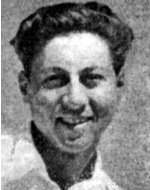Toledano, Yehuda
The youngest son of Chana and Baruch, he was born on 12.6.1925 in Tiberias, where he spent his youth and attended the elementary school at the son of-Yehuda Gymnasium in Tel Aviv, but was forced to stop He began his studies a year later and began studying art, and at the age of 14 he saw in his eyes the night of the killing in Tiberias (8 Tishrei 5659), in which two of his friends were murdered. The sight of the devastation and burning corpses shocked him most, and in the book published by the elementary school on the thirtieth day of the death, he expressed the shame of defeat and the necessity of alertness. This spirit of alertness and alertness prevailed in him from then on and when he reached the age of 16 he was accepted as a member of the Haganah. In the ranks of the Haganah he grew up and became a voter who saw the purpose of his life in strengthening the Jewish defense force. After a day of work, he studied and guided light weapons in Tiberias, Jerusalem and more recently in Tel Aviv. When he was in Tel Aviv, he was arrested on the first day of the “great curfew” and sent to the detention camp in Rafah. Together with other Haganah members, he fought in the camp for a proud and organized stand by all the detainees against the foreign government. When the camp was liquidated in Rafah, he was transferred to Latrun and released after four months in prison. Upon his release he moved to Jerusalem. Where he worked and returned to his position in the Haganah, but his days of vacation were not long and when he came to spend the Sabbath with his parents in Tiberias, the “law-abiding” appeared at night and arrested him again. He was transferred to Latrun, released a few months later and ordered to report daily at the police station in Tel Aviv. Upon his return to Tel Aviv, he began working in an electric refrigeration workshop. At the beginning of the War of Independence in December 1947, after the UN General Assembly decided to partition the country, he abandoned his job and together with a number of former members of the detention center they applied to the recruitment office and asked to volunteer as a cohesive group for full service. But he refused to accept him: “If we young people move to positions on the home front, there will be no one to stop the enemy.” Two months later, he was sent to a course for squad commanders at the Kirya. With the establishment of the Givati Brigade, was joined to one of its battalions and participated in the battalion’s operations in Bam And was sent to the platoon commander (Tzvi Tzur), the battalion that gathered the best fighters among them, and who recorded the ranks of his daring operations with blood. In June 1948, as part of the “Philistine” operation, the Givati forces attacked the Egyptian alignment near the Ashdod Bridge (the “Ad Halom” bridge today), and the forces were forced to retreat. Their progress northward. In this battle he fell on the 3rd of Iyar 5708 (June 3, 1948). Was brought to rest in a grave in the military cemetery in the village of Warburg.
